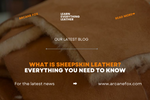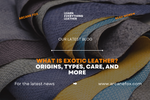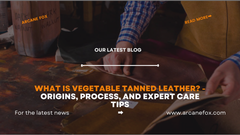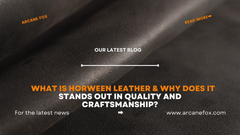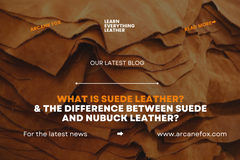What is Lambskin Leather? The Ultimate Guide on Quality, Durability and More
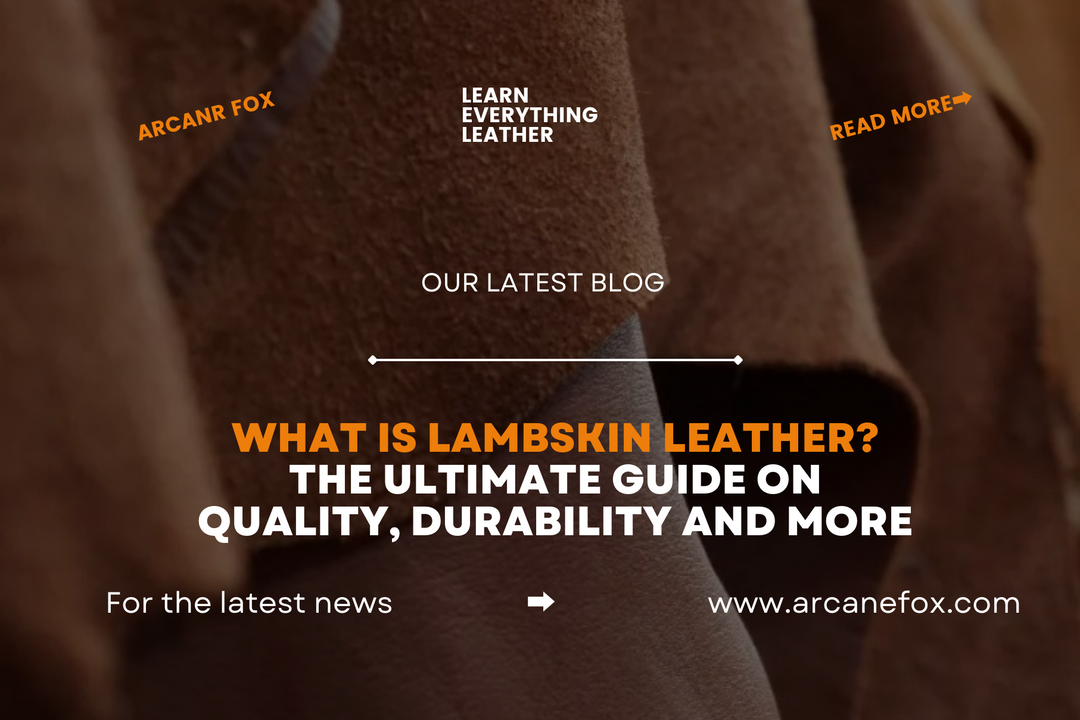
What is Lambskin Leather? The Ultimate Guide on Quality, Durability and More
Leather has for long been held high in esteem due to its stunning appearance and durability. A plus is having sufficient knowledge of the various types of leather, leather treatments, dyes, and craftsmanship standards because it allows you to choose the ideal leather goods. This blog will be a tell-all for lambskin leather in our series of educational blogs on different sorts of leather.
Lambskin leather is well regarde for having a smooth, unblemish appearance that other non-exotic leathers typically lack. It is exceptionally pliable and smooth, making it the ideal material for leather accessories like bags, shoes, and clothing.
You've just landed on the ideal website if you're searching to get a new piece of leather and prefer lambskin. Learn everything there is to know about lambskin leather, including how to take care of it.
1. What is Lambskin Leather?

Lambskin leather is obtain from young sheep with a highly soft, pliable hide. Lambskin leather is undoubtedly more aesthetically pleasing than other types of leather because of the silky soft texture and delicate nature of the hide.
Due to its lightweight, thinness, and flexibility, lambskin leather products is the most comfortable material available. These characteristics make wearing a lambskin leather jacket or coat an impressive fashion choice.
2. Clearing Up Myths & Misconceptions
Lambskin is the subject of ethical criticism, much like calfskin is. It is simple for those who are not familiar with the leather industry to believe that lambs are kill at an early age just for their hide. Lambskin is a byproduct of the meat industry, like the majority of leather produced. Lambs are not raise for their leather; if their skins were not turn into leather, they would otherwise go to waste.
3. How to Identify Lambskin Leather?

When compared to other types of leather, lambskin is relatively lighter. The skin's characteristics are highlight by the silky touch. In general, lambskin is more porous than other types. This necessitates extra security. Additionally, lambskin has more grains.
4. History of Lambskin Leather
One of the earliest domesticated animals was the sheep. In colder climates, their hides were use as shoes in artifacts reaching back to 500 BC. This has frequently occurred throughout history; lambskin boots were use in battle as late as World War 2.
Since that time, lambskin has achieved success in the fashion sector. Shoes, bags, wallets, and other pricey leather products are still made from it.
5. How is Lambskin Leather Manufactured?

Lambskin, which comes from young animals, is undoubtedly delicate. As a result, great care is use during the tanning process to avoid causing any skin tears. Throughout the operation, the leather is handle delicately using certain techniques.
Lambskin is typically color and chemically process after being steep in acids for a period of time. The final product is a smooth, supple lambskin leather that is utilize to create a variety of items.
6. In-depth Characteristics of Lambskin Leather
6.1 Natural or Synthetic
Natural leather produced from young sheep is called lambskin. Vegetable tanning and chromium tanning are the two main tanning processes used for preparing it. The most organic way to enhance the properties of the leather is by using lambskin that has been vegetable-tan. On the other hand, leather that has been chromium-tan can be dye in a variety of hues and patterns and will become softer.
6.2 Surface Texture
The surface smoothness of lambskin is one of its most appealing features. The leather is incredibly soft and smooth, and to highlight the material, it is usually use as a lining for bags or clothing. Small, tight grain patterns that give the leather a slightly rough texture are another characteristic of lambskin.
6.3 Available Thickness
Given that the leather originates from young sheep, it is thin. Lambskin can be found for as little as 4oz (1.6mm). However, the 1oz (.4mm)–3oz (1.2mm) range is where it is most frequently seen. This means that the thickness is not a problem, making it perfect for more delicate items or as a lining.
6.4 Largest Workable Size Of Lambskin Leather
Similar to thickness, the size of the leather is also influence by how young it is when it is harvest. Lambskins typically range from 3-5 square feet in size, although particularly large skins can measure up to 7 square feet. Although the range of lambskin projects is constrained by its size, it is big enough to be made into a tiny purse.
6.5 Flexibility Of Lambskin Leather
Lambskin is a very flexible leather because it is so thin and elastic. On the edge of a table, a lambskin will start to sag. As a result, more content will be need to create projects that are more structured. This flexibility won't obstruct portions of the project that may need to bend when utilized as a lining leather.
6.6 Is Lambskin Leather Softness?
The softness of lambskin is practically unparalleled. Your fingers experience it as flowing through butter. It is obvious why fashion companies use this leather to promote luxury. Additionally, suede, which is much softer, can be create from lambskin leather.
6.7 Suability of lambskin leather
The elasticity and softness of lambskin leather can be problematic when making. Whenever the material is being cut or punch, it will desire to stretch. The leather may pucker at the seams when the thread is tightened, making hand sewing the leather a challenge as well. To prevent the leather from bowing during stitching, you would need to apply less tension on the thread.
6.8 Is Lambskin Leather Durable?
If you treat it well, lambskin leather is incredibly durable. Later in this article, we shall revisit the topic of leather maintenance.
Lambskin leather is ductile and flexible, making it suitable for a variety of items. Lambskin leather is permeable and therefore prone to collecting oil and dirt. To extend the lifespan of your lambskin leather products, you must carefully clean them and avoid allowing too much filth to remain on them.
6.9 How important is the ease of maintenance?
Lambskin will be given leather cleaning and conditioning products, just like the majority of other leathers. The main distinction is that because lambskin leather is thinner, less of each will be need. This implies that while using any types of soap, just tiny amounts should be use so as not to completely saturate the leather.
6.10 Lifespan with Daily Use
Compared to other leathers, lambskin leather has a slightly shorter lifespan. When taken care of and kept up, it can last 15 to 20 years on average. Lambskin requires special maintenance, though, in contrast to other leathers. Abrasion makes the thin, delicate leather extremely rippable.
6.11 Available Colors
Earth tones, blacks, browns, and whites will dominate vegetable-tanned lambskin's color palette. While lambskin that has been chrome-tan can be any color. Lambskin that has been chrome-tan can imitate other leather types by being emboss with patterns or varied textures.
6.12 Is Lambskin Leather Waterproof?
Depending on the tanning process, lambskin leather is only somewhat water resistant and not waterproof. Lambskins that have been vegetable-tanned will quickly absorb water, darkening the leather's color.
Lambskin that has been chrome tanned will offer some protection, but it must be kept as far away from water sources as possible. No matter the tanning technique, it's crucial to dry any exposed leather.
6.13 What Cost Of Lambskin Leather?
The price of lambskin leather is very variable. The more affordable hides start at $3 per square foot. These skins, which are likely to be chrome tan leather, are likely to be thinner and smaller. Premium lambskins can be vegetable tan, thicker, and bigger, and can cost up to $13 per square foot.
6.14 Ease of Crafting
When put to use in making, lambskin leather's properties offer advantages and disadvantages. Although the softer hide makes the material more prone to stretching, the thinner leather makes it easier to cut.
Similar problems arise while stitching leather; while the holes are create smoothly, excessive stress during sewing may cause the leather to bunch. Overall, leather is considerably easier to work with than others once you learn how to work with a softer, thinner hide.
7. How Is Lambskin Leather Different From Other Popular Leather Types?
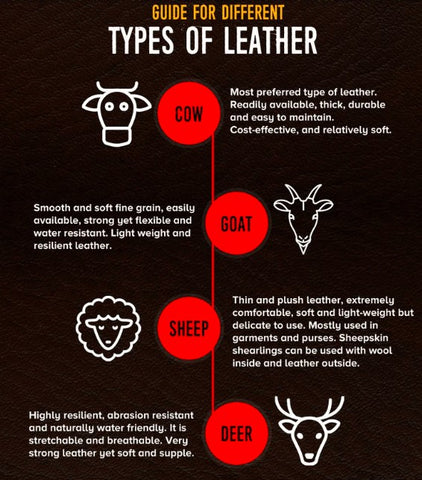
For its wonderful qualities and luxurious feel, lambskin leather is a great choice. But after reading this quick analogy, make your decision on the various leather types.
7.1 Which is Better Lambskin Leather vs Cowhide Leather?
Cowhide leather is the most widely available sort of leather, which is probably attributable in large part to its high tensile strength and accessibility. Cowhide leather is extremely long-lasting and durable. Because of its capacity to patina, it ages well. Cowhide has a gritty texture in addition to the usual flaws that it possesses.
Cowhide leather is stiffer and softer than lambskin leather, which also has a smoother appearance. Lambskin has a reputation for being a luxurious material since it is more aesthetically pleasing. Lambskin leather also lasts for decades with proper maintenance.
7.2 Which is Better Lambskin Leather vs Sheepskin Leather?
The main distinction between sheepskin leather and lambskin leather is that the latter is made from the mature sheep hide while the former is obtained from young animals. Lambskin beats out sheepskin in terms of softness, stretchability, and thinness.
Compared to lambskin leather, sheepskin is more resilient and less prone to scuffs and scratches. Lambskin requires a lot of upkeep due to its fragility in order to prevent harm of any types.
7.3 Which is Better Lambskin Leather vs Goatskin Leather?
Lambskin leather is less durable and has a lower tensile strength than goatskin leather. Its distinct pebbled grain gives it a special feel.
Lambskin might not be the best material for vigorous sports like biking and trekking. Goatskin is a good material option for biker jackets for men or women. Goatskin leather is a good choice for a personalized leather jacket because it will protect you better than lambskin.
However, lambskin would be a superior option if your decision was based on the weight, feel, and flexibility of the leather product.
8. What are Pros And Cons Of Lambskin Leather
8.1 Pros of Lambskin Leather
- It has a smooth, velvety touch.
- Lambskin leather is highly flexible.
- Available in all colors.
- The fur on the inner side of the leather feels great and keeps you snug and warm.
- Lambskin leather gives off luxe vibes.
- It is very thin and lightweight, appropriate for spring and summer jackets.
8.2 Cons of lambskin leather
- Lambskin leather is more prone to damage due to its delicate nature and thinness.
- It is more expensive than other types of non-exotic leathers, particularly cowhide and sheepskin.
- It is a high maintenance leather that needs proper care on a regular basis.
- Lambskin leather is not waterproof.
9. Lambskin Leather Care and Maintenance

9.1 How to Clean Lambskin Leather?
Lambskin may be clean in the same way as other leathers. It is preferable to begin by using a horsehair brush to dust off the leather and light amounts of leather soap. After applying, work the soap into the leather in a circular motion, then wipe off any extra.
Pay particular attention to how much liquid is pour into the leather because lambskin leather is much thinner than other leathers. Considering that it can easily become saturated, leading to accidental color changes.
9.2 How to Condition Lambskin Leather?
After cleaning, lambskin leather can be condition. Before massaging it into the bag, apply the leather conditioner to a clean towel first. To avoid saturation, it's vital to work in little increments. Apply some leather conditioner to a concealed place to test it out and see how it affects the hide.
9.3 How to Store Lambskin Leather?

Lambskin leather is sensitive, thus it needs to be store properly to keep it from deteriorating. It should ideally be kept in a dust bag, out of the sun and water, and in a cool location. The best course of action would be to isolate the leather because lambskin is prone to wear from abrasion.
10. Conclusion
Overall, lambskin leather products is a high-end material that is utilize to create a variety of items. Most leather jackets made of leather require full-grain lambskin. Compared to many other varieties of leather, lambskin is softer and smoother. Both benefits and drawbacks can be found in lambskin. It is a summer or springtime necessity to wear lightweight leather. Although lambskin leather is waterproof, it is also strong and, with proper care, can last for decades.
Learn more about leather here Leather 101 - The Ultimate Guide to Different Types of Leather
Related Topics
- What is Cowhide Leather? Origins, Types, and Maintenance
- What is Goatskin Leather? Different Types of Goatskin, Quality, Durability and More
- What is Sheepskin Leather? Everything You Need To Know
- What is Exotic Leather? Origins, Types, Care, and more
- What is Calfskin Leather? It's Quality & Durability Against Other Leather!
- What Is Shearling Leather? The Truth No One Told You About This Luxe Material

